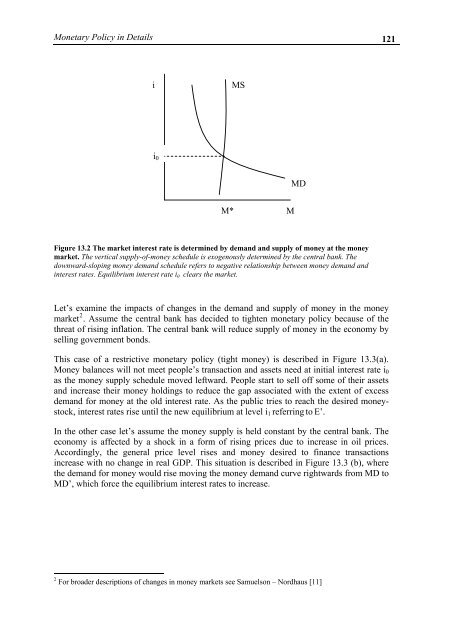MacroeconomicsI_working_version (1)
You also want an ePaper? Increase the reach of your titles
YUMPU automatically turns print PDFs into web optimized ePapers that Google loves.
Monetary Policy in Details 121<br />
i<br />
MS<br />
i 0<br />
M*<br />
MD<br />
M<br />
Figure 13.2 The market interest rate is determined by demand and supply of money at the money<br />
market. The vertical supply-of-money schedule is exogenously determined by the central bank. The<br />
downward-sloping money demand schedule refers to negative relationship between money demand and<br />
interest rates. Equilibrium interest rate i 0 clears the market.<br />
Let’s examine the impacts of changes in the demand and supply of money in the money<br />
market 2 . Assume the central bank has decided to tighten monetary policy because of the<br />
threat of rising inflation. The central bank will reduce supply of money in the economy by<br />
selling government bonds.<br />
This case of a restrictive monetary policy (tight money) is described in Figure 13.3(a).<br />
Money balances will not meet people’s transaction and assets need at initial interest rate i 0<br />
as the money supply schedule moved leftward. People start to sell off some of their assets<br />
and increase their money holdings to reduce the gap associated with the extent of excess<br />
demand for money at the old interest rate. As the public tries to reach the desired moneystock,<br />
interest rates rise until the new equilibrium at level i 1 referring to E’.<br />
In the other case let’s assume the money supply is held constant by the central bank. The<br />
economy is affected by a shock in a form of rising prices due to increase in oil prices.<br />
Accordingly, the general price level rises and money desired to finance transactions<br />
increase with no change in real GDP. This situation is described in Figure 13.3 (b), where<br />
the demand for money would rise moving the money demand curve rightwards from MD to<br />
MD’, which force the equilibrium interest rates to increase.<br />
2 For broader descriptions of changes in money markets see Samuelson – Nordhaus [11]




